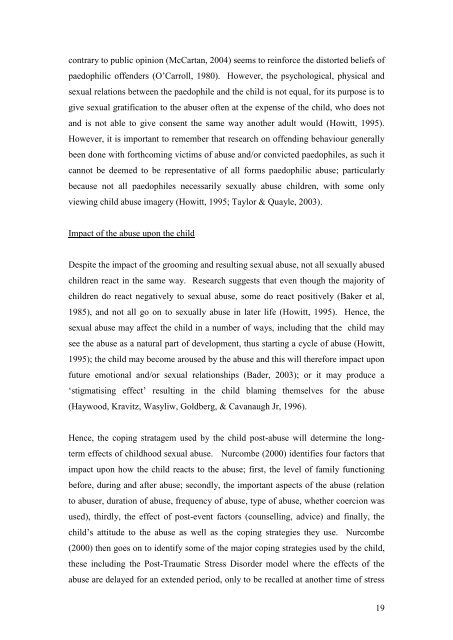McCartan, K. (2008) Current understandings of paedophilia and the ...
McCartan, K. (2008) Current understandings of paedophilia and the ...
McCartan, K. (2008) Current understandings of paedophilia and the ...
You also want an ePaper? Increase the reach of your titles
YUMPU automatically turns print PDFs into web optimized ePapers that Google loves.
contrary to public opinion (<strong>McCartan</strong>, 2004) seems to reinforce <strong>the</strong> distorted beliefs <strong>of</strong><br />
paedophilic <strong>of</strong>fenders (O‟Carroll, 1980). However, <strong>the</strong> psychological, physical <strong>and</strong><br />
sexual relations between <strong>the</strong> paedophile <strong>and</strong> <strong>the</strong> child is not equal, for its purpose is to<br />
give sexual gratification to <strong>the</strong> abuser <strong>of</strong>ten at <strong>the</strong> expense <strong>of</strong> <strong>the</strong> child, who does not<br />
<strong>and</strong> is not able to give consent <strong>the</strong> same way ano<strong>the</strong>r adult would (Howitt, 1995).<br />
However, it is important to remember that research on <strong>of</strong>fending behaviour generally<br />
been done with forthcoming victims <strong>of</strong> abuse <strong>and</strong>/or convicted paedophiles, as such it<br />
cannot be deemed to be representative <strong>of</strong> all forms paedophilic abuse; particularly<br />
because not all paedophiles necessarily sexually abuse children, with some only<br />
viewing child abuse imagery (Howitt, 1995; Taylor & Quayle, 2003).<br />
Impact <strong>of</strong> <strong>the</strong> abuse upon <strong>the</strong> child<br />
Despite <strong>the</strong> impact <strong>of</strong> <strong>the</strong> grooming <strong>and</strong> resulting sexual abuse, not all sexually abused<br />
children react in <strong>the</strong> same way. Research suggests that even though <strong>the</strong> majority <strong>of</strong><br />
children do react negatively to sexual abuse, some do react positively (Baker et al,<br />
1985), <strong>and</strong> not all go on to sexually abuse in later life (Howitt, 1995). Hence, <strong>the</strong><br />
sexual abuse may affect <strong>the</strong> child in a number <strong>of</strong> ways, including that <strong>the</strong> child may<br />
see <strong>the</strong> abuse as a natural part <strong>of</strong> development, thus starting a cycle <strong>of</strong> abuse (Howitt,<br />
1995); <strong>the</strong> child may become aroused by <strong>the</strong> abuse <strong>and</strong> this will <strong>the</strong>refore impact upon<br />
future emotional <strong>and</strong>/or sexual relationships (Bader, 2003); or it may produce a<br />
„stigmatising effect‟ resulting in <strong>the</strong> child blaming <strong>the</strong>mselves for <strong>the</strong> abuse<br />
(Haywood, Kravitz, Wasyliw, Goldberg, & Cavanaugh Jr, 1996).<br />
Hence, <strong>the</strong> coping stratagem used by <strong>the</strong> child post-abuse will determine <strong>the</strong> long-<br />
term effects <strong>of</strong> childhood sexual abuse. Nurcombe (2000) identifies four factors that<br />
impact upon how <strong>the</strong> child reacts to <strong>the</strong> abuse; first, <strong>the</strong> level <strong>of</strong> family functioning<br />
before, during <strong>and</strong> after abuse; secondly, <strong>the</strong> important aspects <strong>of</strong> <strong>the</strong> abuse (relation<br />
to abuser, duration <strong>of</strong> abuse, frequency <strong>of</strong> abuse, type <strong>of</strong> abuse, whe<strong>the</strong>r coercion was<br />
used), thirdly, <strong>the</strong> effect <strong>of</strong> post-event factors (counselling, advice) <strong>and</strong> finally, <strong>the</strong><br />
child‟s attitude to <strong>the</strong> abuse as well as <strong>the</strong> coping strategies <strong>the</strong>y use. Nurcombe<br />
(2000) <strong>the</strong>n goes on to identify some <strong>of</strong> <strong>the</strong> major coping strategies used by <strong>the</strong> child,<br />
<strong>the</strong>se including <strong>the</strong> Post-Traumatic Stress Disorder model where <strong>the</strong> effects <strong>of</strong> <strong>the</strong><br />
abuse are delayed for an extended period, only to be recalled at ano<strong>the</strong>r time <strong>of</strong> stress<br />
19

















